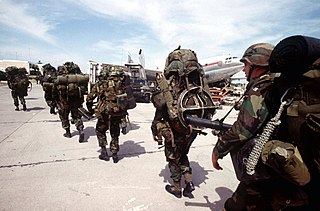
Operation Uphold Democracy was a multinational military intervention designed to remove the military regime led and installed by Raoul Cédras after the 1991 Haitian coup d'état overthrew the elected President Jean-Bertrand Aristide. The operation was effectively authorized by the 31 July 1994 United Nations Security Council Resolution 940.

Michael R. Lehnert is a retired major general of the United States Marine Corps. He supervised the construction and served as the first commandant of the Guantanamo Bay Detention Camp.
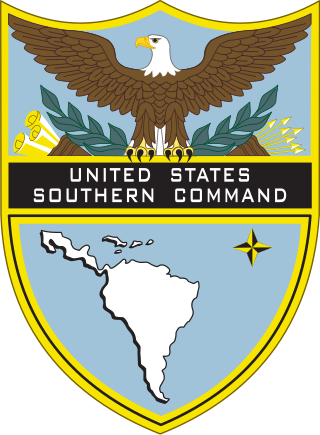
The United States Southern Command (USSOUTHCOM), located in Doral in Greater Miami, Florida, is one of the eleven unified combatant commands in the United States Department of Defense. It is responsible for providing contingency planning, operations, and security cooperation for Central and South America, the Caribbean, their territorial waters, and for the force protection of U.S. military resources at these locations. USSOUTHCOM is also responsible for ensuring the defense of the Panama Canal and the canal area.
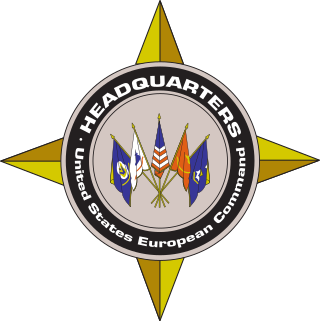
The United States European Command (EUCOM) is one of the eleven unified combatant commands of the United States military, headquartered in Stuttgart, Germany. Its area of focus covers 21,000,000 square miles (54,000,000 km2) and 51 countries and territories, including Europe, The Caucasus, Russia and Greenland. The Commander of the United States EUCOM simultaneously serves as the Supreme Allied Commander, Europe (SACEUR) within NATO, a military alliance. During the Gulf War and Operation Northern Watch, EUCOM controlled the forces flying from Incirlik Air Base.

Marine Medium Tiltrotor Squadron 774 (VMM-774) is a United States Marine Corps medium tiltrotor squadron consisting of V-22 Osprey tiltrotor aircraft. The squadron, known as the "Wild Goose", is a United States Marine Corps Reserve unit based at Marine Corps Air Station New River, North Carolina and falls under the command of Marine Aircraft Group 49 (MAG-49) and the 4th Marine Aircraft Wing.
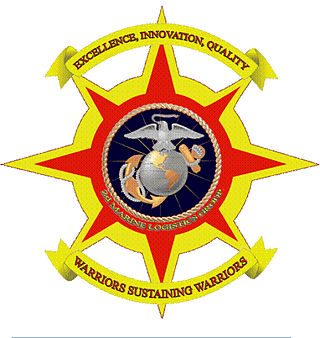
The 2nd Marine Logistics Group is a logistics unit of the United States Marine Corps and is headquartered at Marine Corps Base Camp Lejeune, North Carolina. 2nd MLG was formerly known as 2nd Force Service Support Group (FSSG), reorganized with its sister FSSGs into Marine Logistics Groups in 2005. The 2nd MLG is composed of approximately 8,000 marines and sailors.

The Banana Wars were a series of conflicts that consisted of military occupation, police action, and intervention by the United States in Central America and the Caribbean between the end of the Spanish–American War in 1898 and the inception of the Good Neighbor Policy in 1934. The military interventions were primarily carried out by the United States Marine Corps, which also developed a manual, the Small Wars Manual (1921) based on their experiences. On occasion, the United States Navy provided gunfire support and the United States Army also deployed troops.

3rd Battalion, 24th Marines (3/24) was a reserve infantry battalion in the United States Marine Corps. The battalion was first formed in 1943 for service in the Pacific Theater of Operations during World War II, taking part in a number of significant battles including those at Saipan and Iwo Jima before being deactivated at the end of the war. In the early 1960s, the unit was reactivated as a reserve battalion. It was located throughout the Midwestern United States and consisted of approximately 800 marines and sailors. The battalion was part of the 24th Marine Regiment and the 4th Marine Division. Recent operations included tours in Iraq and Afghanistan. On May 19, 2013, the battalion was deactivated (retired) as a part of 2013 Marine Corps Force Restructuring, along with the 24th Marine Regiment. 3/24 personnel were reallocated to 23rd Marine Regiment, with the majority of the companies becoming 3rd Battalion, 23rd Marines.

The United States Fleet Marine Forces (FMF) are combined general- and special-purpose forces within the United States Department of the Navy that perform offensive amphibious or expeditionary warfare and defensive maritime employment. The Fleet Marine Forces provide the National Command Authority (NCA) with a responsive force that can conduct operations in any spectrum of conflict around the globe.

The United States Marine Corps is organized within the Department of the Navy, which is led by the Secretary of the Navy (SECNAV). The most senior Marine commissioned officer is the Commandant of the Marine Corps, responsible for organizing, recruiting, training, and equipping the Marine Corps so that it is ready for operation under the command of the unified combatant commanders. The Marine Corps is organized into four principal subdivisions: Headquarters Marine Corps, the Operating Forces, the Supporting Establishment, and the Marine Forces Reserve.
The structure of the United States Navy consists of four main bodies: the Office of the Secretary of the Navy, the Office of the Chief of Naval Operations, the operating forces, and the Shore Establishment.

The Commander, U.S. Marine Corps Forces Command (COMMARFORCOM), headquartered at the Naval Support Activity Hampton Roads in Norfolk, Virginia, commands service retained-operating forces; executes force sourcing and synchronization to affect force generation actions in the provisioning of joint capable Marine Corps forces, and directs deployment planning and execution of service retained-operating forces in support of Combatant Commander (CCDR) and service requirements; serves as Commanding General, Fleet Marine Force, Atlantic and commands embarked Marine Corps forces; coordinates Marine Corps-Navy integration of operational initiatives and advises CDR U.S. Fleet Forces Command (USFF) on support to Marine Corps forces assigned to naval ships, bases, and installations; conducts Service directed operational tasks as required. COMMARFORCOM is also the Commander, Marine Corps Forces Northern Command (MARFORNORTH), the Marine service component command of U.S. Northern Command.

United States Naval Districts is a system created by the United States Navy to organize military facilities, numbered sequentially by geographic region, for the operational and administrative control of naval bases and shore commands in the United States and around the world. Established in 1903, naval districts became the foundational system for organizing U.S. naval forces ashore during the 20th century. The term "Naval" forces includes United States Marine Corps and current United States Coast Guard units.
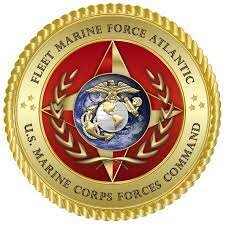
The Fleet Marine Force, Atlantic (FMFLANT) is an American maritime landing force that is spread across the Atlantic Ocean. It is headquartered at Naval Station Norfolk and directs and commands all the subordinate elements of the Navy Expeditionary Strike Force and Marine Air-Ground Task Force components that follow under the 2nd, 4th, and 6th Fleet and the Marine Forces Command (MarForCom). The Commanding General of Marine Forces Command is dual-posted as the Commanding General of the Fleet Marine Force, Atlantic. FMFLANT is under operational control of the Commander-in-Chief, United States Fleet Forces Command, when deployed.

The Marine Corps Forces Europe and Africa, headquartered in Panzer Kaserne-Barracks in Böblingen, Germany, is the U.S. Marine Corps component of the U.S. European Command and U.S. Africa Command.

The United States Marine Corps (USMC), also referred to as the United States Marines, is the maritime land force service branch of the United States Armed Forces responsible for conducting expeditionary and amphibious operations through combined arms, implementing its own infantry, artillery, aerial, and special operations forces. The U.S. Marine Corps is one of the eight uniformed services of the United States.

The Force Headquarters Group (FHG) is a major subordinate command (MSC) of the United States Marine Corps based in New Orleans, Louisiana. It was established as a part of the command element for Marine Forces Reserve. It was activated on July 18, 2012, assuming command of six MARFORRES Force-level units: 3rd and 4th Air Naval Gunfire Liaison Companies, 3rd and 4th Civil Affairs Groups, 6th Communications Battalion and Intelligence Support Battalion.

Lieutenant General James Tillinghast Moore was a decorated Officer and aviator in the United States Marine Corps, he is most noted for his service as commanding general of the 2nd Marine Aircraft Wing during World War II.
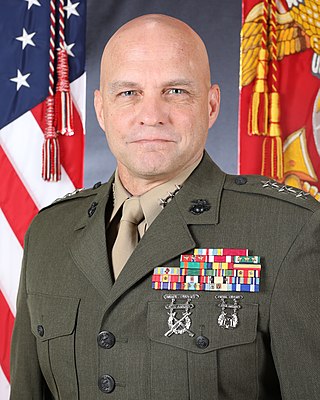
David G. Bellon is a retired United States Marine Corps lieutenant general who served as the commander of the United States Marine Corps Reserve and Marine Corps Forces, South. He previously commanded Marine Forces South from May 2017 to August 2018, ceding control to Major General Michael F. Fahey III.


















